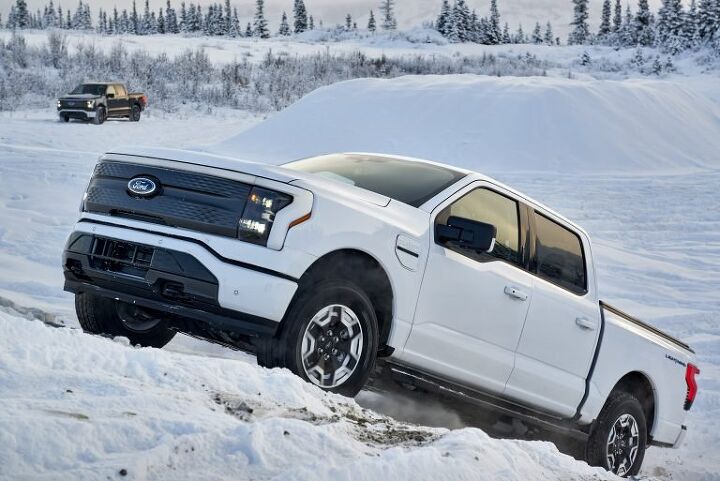Opinion: These Brands Won't Make It in the US (as EVs)

Unless you’ve been living under a rock since 2019, you’ve probably realized that just about every major carmaker has plans to go “fully electric” at some point in the rapidly approaching future. That’s going to mean big changes in the way we buy and use cars, obviously— but change is hard, and not every company is going to be willing or able to make those changes.
That equally obvious fact begs the question: who’s not gonna make it?
In my other life as a podcaster and EV enthusiast, I have very different conversations with people than I do in this life as a “car guy” who wants to talk about drag racing and dirt ovals. During one of those conversations with a guy named Phil Gross, we talked about the approximately 15 million new cars sold in the US each year.
I already knew that 15 million number, so I wasn’t surprised when Phil brought it up. I was surprised, however, when Phil told me that there simply isn’t enough lithium on Earth to keep producing cars at anything like that rate and that North American carmakers would soon be facing, “an existential threat” (his words) as they transition to EVs.
Phil should know. He’s the CEO of Snow Lake Lithium, a hard-rock mining operation up in Snow Lake, Manitoba, Canada, and it is quite literally his job to know (or, at least, try to know) precisely how much lithium is out there … and he’s not terribly optimistic.
“Right now, I can tell you precisely how much lithium is being mined in North America, to the ounce,” he says. “Zero,” he makes an “O” with his hand, driving the point home.
We went on to talk about China and South America and how they didn’t want to export lithium to the US, and the relative merits of hard rock mining vs. extracting lithium from brine solutions, but that’s not what stuck with me.
What did stick was this: no matter how you slice it, or where you look for it, there’s not enough lithium to keep up. If the manufacturers and politicians stick to their EV-only plans, some brands will be muscled out of the market simply because they can’t get enough materials. Who will they be?
It’s impossible to know, of course. But here’s my shortlist of … let’s go with, “educated guesses.”
MAZDA
I want Mazda to succeed. I want the scrappy little maker of high-quality, Kaizen-infused sporty cars to make it into the electric future with lightweight, low-mid range EVs with compact batteries that charge up lickity-quick and fight range anxiety with a hushed, mildly creepy kid whispering, “Zoom zoom.”
That’s not going to happen, though. For one thing, relatively tiny Mazda doesn’t have the cash on hand to develop something like that on its own— and its most likely big-budget partners, Toyota, are the biggest EV holdouts as it is.
That’s not to say Mazda is doomed. In fact, Mazda’s strategy seems to be to redouble its efforts at perfecting the internal combustion engine and focus its marketing in Southeast Asian markets where an electric vehicle infrastructure is even further away than it might be here. You can see that in its latest, excellent diesel-engine hybrid and its 406 lb-ft. of torque.
3.3 LITER MAZDA SKYACTIV-D INLINE-SIX
Will a diesel hybrid fly in the US? Despite all the very good environmental arguments for low-cost hybrids and biodiesels, there’s no way. The EV purists have won the information war, and Mazda will have to look elsewhere— maybe in countries where they’re already selling diesel pickup trucks?
MINI
If there was ever a brand that could make a compact, short-range EV that was so much fun to drive that you didn’t care about its range, it should have been Mazda. They didn’t, which brings us to our next great green hope: Mini.
To be clear, Mini already has an EV. A sort of good one, if you’re judging it from the driver’s seat instead of a spec sheet. It’s enough fun to make you overlook the short range most of the time (assuming you have a second car to take on longer trips), but in this world of chip shortages and supply chain blockages and a demand curve for lithium that outpaces the supply curve like Usain Bolt outpaces, well— me!— Mini’s parent company BMW simply won’t keep making Mini Coopers. Not when they could use that lithium in a more profitable BMW i7 or i4 M50 Gran Coupe, you know?
Especially not in a seller’s market that’s packed with buyers who are willing to pay tens of thousands of dollars above sticker. The money is there, in other words, and the limiting factor is going to make sure that each battery built goes into the most profitable vehicle possible.
DODGE
I could take the low road here and say something about how the “Let’s Go Brandon” crowd will be the absolute last of the internal combustion holdouts, but there are two problems with that. The first is that I don’t actually think that’s true (Infiniti will be last, before they fold— more on them in a minute), and the second is that Dodge will die for the same cynical reason Mini will probably die: there are more profitable brands in Stellantis’ portfolio to funnel lithium into.
That is unless they build a proper electric Charger that is packed with all the go-fast goodies and can sell it for Hellcat money (that car starts at $74,900). Still, that’s one car— and a sedan, at that. Could really say that Dodge was surviving if its only model was a premium sedan?
No, Stellantis is smart. They’ll keep funneling Lithium to big electric Ram trucks, high-end Jeep Wagoneers, and special edition Wranglers … and maybe just enough Chrysler crossovers to delude themselves into thinking they’ve got a Model Y competitor.
Dodge? Like the Plymouth and Eagle brands the last time Chrysler did this, there just might not be a place for it anymore. And that’s too bad— a low-cost electric Neon with modern LED interior mood lighting would be killer!
INFINITI
Corey Lewis has already done a stellar job charting Infiniti’s downward trajectory in recent years, and I won’t do him (or you) the injustice of putting my own spin on it. Go read his piece, then come back here and try to imagine a world where the tenuous Renault-Nissan-Mitsubishi, already under pressure from Renault’s plan to spin its EV operations off into a separate company, actually gets it right.
Infiniti could so easily get it right, too. A big, electric Q45 with semi-active suspension and torque vectoring could be the big sedan that puts Infiniti back on the map. Another slinky, sexy SUV coupe? The market is packed with them, but Infiniti was one of the innovators here, and their stylists just might be able to make some magic happen if they drop that goofy, Power Rangers-inspired grille.
Heck, dumping all the resources they can get their mitts on into their most expensive product line while letting their volume players waste away into irrelevance with nothing but minor cosmetic and trim updates for a decade and a half might actually be the smart move. For the first time in history, it seems, it’s the high-dollar enthusiast play that will win the day— and Infiniti could pull it off. Acura already blew it with their high-tech NSX hybrid monstrosity (Was a mid-engined Accord really too much to ask for?), but Infiniti?
Infiniti won’t get it right. They can’t. It’s in whatever’s left of their DNA, and Nissan doesn’t care enough to even try to save them.
[Images: Ford, Mazda, Chrysler/Stellantis]

I've been in and around the auto industry since 1997, and have written for a number of well-known outlets like Cleantechnica, the Truth About Cars, Popular Mechanics, and more. You can also find me talking EVs with Matt Teske and Chris DeMorro on the Electrify Expo Podcast, writing about Swedish cars on my Volvo fan site, or chasing my kids around Oak Park.
More by Jo Borras
Latest Car Reviews
Read moreLatest Product Reviews
Read moreRecent Comments
- Jalop1991 This is easy. The CX-5 is gawdawful uncomfortable.
- Aaron This is literally my junkyard for my 2001 Chevy Tracker, 1998 Volvo S70, and 2002 Toyota Camry. Glad you could visit!
- Lou_BC Let me see. Humans are fallible. They can be very greedy. Politicians sell to the highest bidder. What could go wrong?
- SPPPP Vibrant color 9 times out of 10 for me. There may be a few shapes that look just right in metallic gray, for example. There are a few nices ones out there. And I like VW "White Silver". But I'd usually prefer a deep red or a vibrant metallic green. Or a bright blue.
- 28-Cars-Later Say it ain't so, so reboot #6* isn't going to change anything?[list=1][*]V4-6-8 and High "Tech" 4100.[/*][*]Front wheel drive sooooo modern.[/*][*]NOrthSTARt.[/*][*]Catera wooooo.[/*][*]ATS all the things.[/*][*]We're *are* your daddy's Tesla. [/*][/list=1]




































Comments
Join the conversation
Neon really would make a perfect name for an EV model. Given the way they whored out the name to Dodge, Plymouth and Chrysler (in intl markets), either Dodge or Chrysler could take a Neon EV now. Or it could start with one brand and move to the other if the first brand dies (like Voyager and Prowler).
It seems to me that "Phil" is being facetious and pulling your leg; from what I understand, there are several pumped salt water operations in the desert southwest, plus an unknown amount of lithium accessible in the area of the Bonneville Salt Flats and the Salton Sea. I also understand that Bolivia has one of the world's largest lithium outcrops, which has yet to be touched. Now, if I'm wrong about this, I'd like to know, because I read this data several years ago when somebody else tried to claim there would be a "Lithium Cliff." That said, numerous more recent articles are already reporting that battery technology is moving away from lithium and towards iron and other much more common materials. So even if there is a "Lithium Cliff", by the time we hit it, we won't need it any more. What we do need, however, is an organized manner to collect and recycle used household batteries such as Alkaline and yes, lithium and other rechargeables.